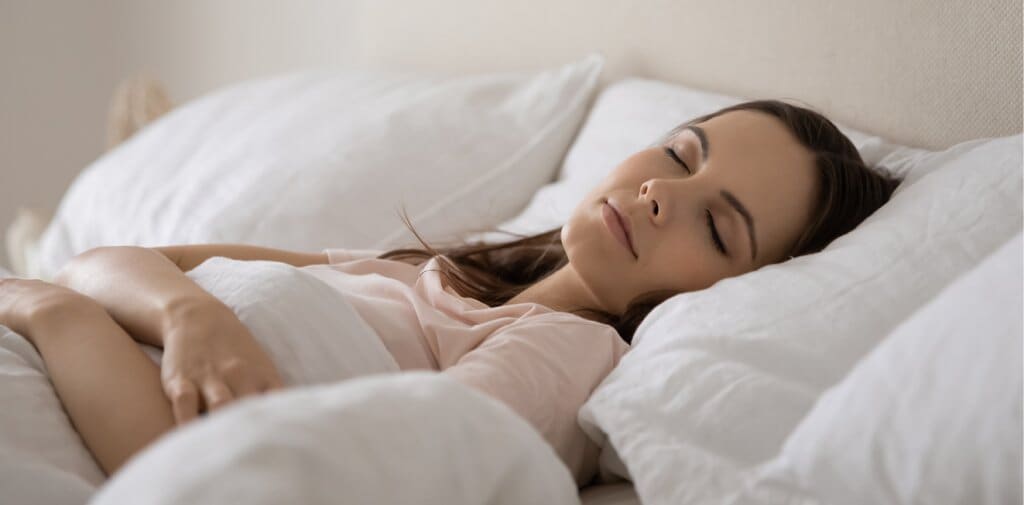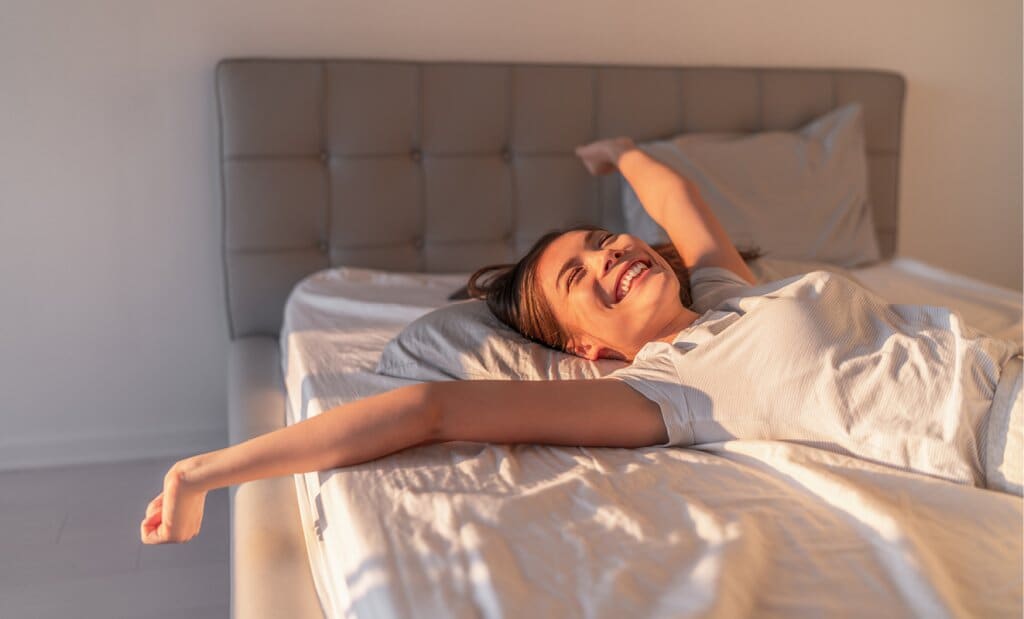If you have trouble falling asleep because you simply cannot quiet your thoughts. Or you tense up worrying about what tomorrow may bring, you’re not alone. Recent research found that around 36% of people have trouble sleeping at least once a week.
A couple of ‘bad nights’ here and there is nothing to worry about too much. But if you start to see a pattern in your sleeping problems, then not only could you be waking up tired and irritable. But eventually, it could start to affect your mental and physical health. So, what can you do?
We are sharing methods that you can try to help you drift off more easily.
What are breathing techniques?
Breathing may seem to be one of those things you simply ‘do’ without thinking about it. But mindful breathing or breathing techniques allow you to become consciously aware of the act of breathing. They let you focus on the act of breathing, and how your body feels as your lungs fill and empty.
They also shift the focus from the shallow, ‘top-of-the-lungs’ breathing that we normally do throughout the day. And, towards a more slow, deep, rhythmic breathing. This allows the lungs to work to their best capacity when you both inhale and exhale.

Why you should try breathing techniques
Chemical aids such as sleeping tablets are very much a last resort. Prolonged use can result in the ‘wrong’ kind of sleep. Basically, a drug-induced sleep rather than a pattern that goes through natural cycles. They can also become addictive if taken too often.
A more natural option is to try breathing techniques to help you sleep. Relaxation and breathing techniques come in a myriad of different forms. From counting breaths to visualisation.
Before you climb into bed and try out the 4-7-8 breathing technique (more on that in a minute), make sure you, your bedroom, and your bed are ready for some relaxation:
- Try to avoid drinking or eating just before you go to bed. Your body will be busy trying to digest food and drink. This could result in a bathroom visit interrupting your sleep later on.
- Avoid using devices such as mobile phones or tablets.
- Invest in an old-fashioned alarm clock and leave the mobile phone downstairs. This is so you’re not tempted to look at it every five minutes!
- Reduce the temperature in your bedroom to an optimum of 15.35-19.4°C.
- Make sure your bed is made and that your mattress is comfortable.
What are the best breathing techniques to help you sleep?
There are a variety of different breathing exercises you can try to help you relax. Our top tip, though, is don’t give up if it doesn’t work straight away! Breathing exercises can take a little time to work.
One of the most common is the 4-7-8 technique. Or you can try something a little simpler such as humming.
1. Diaphragmatic Breathing
Also known as ‘Belly Breathing’. This technique works the muscle at the bottom of the lungs. It can help relax and destress you. It can also help people with respiratory conditions like asthma improve their lung function.
- Lie down and place one hand on your chest and the other on your belly.
- Breathe in through your nose until your belly pushes hard against your hand. Keep your other hand and your chest still.
- Engage your core muscles, purse your lips, and exhale as if you’re whistling.
- Repeat for a few minutes and then slowly relax your body.
2. Meditative breath
Meditative or ‘mindful’ breathing lets you focus fully on every breath you take. It’s a technique that’s been used for thousands of years and works at any time of the day or night.
- Make sure you’re comfortable. Close your eyes and give yourself a few moments to relax and become calm.
- Take a deep breath in, inhaling through your nostrils, trying to fill your lungs as much as you can.
- Slowly exhale through your mouth, focusing on the sensation of the air leaving your body.
- Repeat this process twice more, each time slowly exhaling.
- Pause and repeat.
3. Alternating nostril breath
Alternating nostril breathing is a yogic method that also works to help you relax at the end of a busy day. Focus on the process and try to keep your breathing as smooth as possible.
- Make sure you’re comfortable.
- Exhale completely, and then press your forefinger or thumb against your right nostril until it’s closed.
- Inhale through your left nostril and then close it with your fingers.
- Exhale through your now-open right nostril.
- Now, keeping the right nostril open, inhale deeply and then close off the right nostril with your thumb.
- Open your right nostril by removing your fingers and exhaling through the left side.
- This is a complete cycle. Repeat for a few minutes.
4. 4-7-8 Relaxing breath
This is one of the most commonly recommended techniques for anyone suffering from insomnia. It’s slightly more advanced. But don’t worry, it’s actually quite straightforward to master. If you don’t feel comfortable holding your breath, try some of the alternative methods first.
- Place the tip of your tongue behind your front teeth and press up to the roof of your mouth. Keep it in this position for the entire process.
- Inhale through your nose for a slow count of four
- Hold your breath for a slow count of seven
- Exhale through your mouth over a slow count of eight and finish as if you’re blowing out a candle.
- Repeat for a few minutes or for as long as you feel comfortable.
5. Humming bee breath
Also known as Bhramari Pranayama, this is a great technique to use if you feel anxious or stressed out. We instinctively use this technique as children as the act of humming is therapeutic. It also releases endorphins into the body, creating a calming effect.
- Take a few natural breaths and close your eyes.
- Keep your lips tightly sealed and inhale through your nose.
- As you exhale, make the sound of the letter M. Keep humming until you feel the need to inhale again.
- Repeat by inhaling through your nose and humming as you exhale.
If you feel self-conscious doing this exercise, make sure you’re on your own so that anxiety doesn’t counter the calming effects.
6. Lengthened breath
This is one of the easiest and quickest ways to relax when you’re trying to get off to sleep. Lengthened breathing lets the parasympathetic nervous system take over. This relaxes you physically.
- Relax into a comfortable position.
- Breathe in for two seconds through your nose and breathe out for four seconds through your mouth.
- Repeat this for a couple of minutes.
- Then, breathe in for three seconds through your nose and out for six seconds through your mouth.
- Repeat for a couple of minutes.
- Ensure that your exhales are twice as long as your inhales (so inhale for four seconds and exhale for eight, for example).
Can your mattress affect your sleep?

Your mattress has a huge bearing on the quality of your sleep, from the firmness rating to the type of mattress (memory foam or spring mattress, for example).
If your mattress is old, lumpy, and uncomfortable, it will impact the quality of your sleep immensely. Our top tip is to replace your mattress every eight years to avoid it deteriorating.
If your mattress is comfortable, you’re more likely to relax. So, when you practice those breathing techniques, they’ll be more effective.
If your mattress is past its sell-by date, is too soft or too hard, or you simply want to replace it for a better-quality mattress, check out the selection available at MattressNextDay. You can also find out more about choosing the right mattress.





